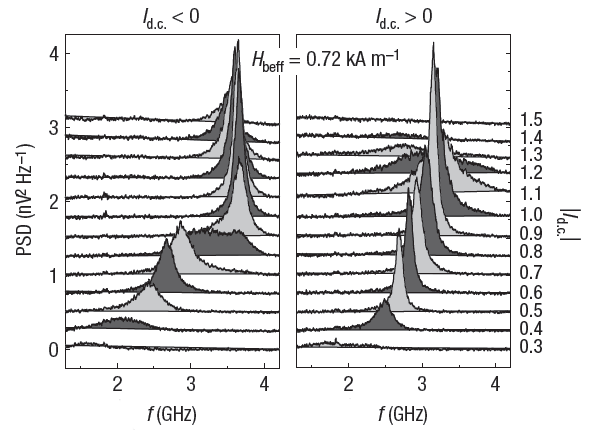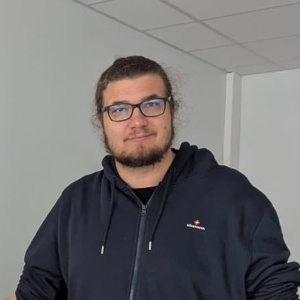Overview
Microwave oscillations of the magnetization around its equilibrium are the natural dynamical response to external perturbations (e.g. thermal fluctuations, microwave fields). This offers the promise for a new class of microwave devices, benefiting from their small foot-print, their ability to be controlled electrically, and their integrability with CMOS technology. Identified devices include local oscillators, microwave filters, detectors, and non-reciprocal devices. Understanding the dynamics of these nano-objects, applying general concepts of microwave oscillator techniques and defining from this novel microwave applications is the major aim of this activity.
Research directions
Spin Transfer Torque Oscillators

We are realizing and studying microwave emitting sources based on the magnetization precession, mainly in the shape of nanopillars made out of magnetic heterostrucures. This offer the possibility to build new devices for telecommunication in the Ghz range.
The team
Former members
Post-docs
- Sylvain MOULIS
- Artem LITVINENKO
- Pankaj ZETHI
- Alumni : A. Ruiz Calafora, K. Jaimes Merazzo, K. Garcia Hernandez, C. Murapaka
PhD
- Alumni : Matthieu Favre, Jérôme Hem, Anike Purbawati
Visitors
- W.E. Bailey – Columbia University (2009, 2010, 2011, 2012), A. N. Slavin – Oakland University (2012, 2013), V. Naletov (2016)
Recent news
- [POSITION FILLED] Post-doctoral positions – Coupled nano-oscillator arrays for brain inspired computing (August 04th, 2021)
![[POSITION FILLED] Post-doctoral positions - Coupled nano-oscillator arrays for brain inspired computing](https://www.spintec.fr/wp-content/uploads/2021/08/2021-08-ai-post-docs-100x70.png)
SPINTEC laboratory (Grenoble, France), in collaboration with CEA-LETI, has currently two postdoc position openings to work on theory (12 month) and on experiment (18 month) of coupled oscillator arrays for implementing neuromorphic and unconventional computing ... - Spin-information transported over long-distances at room temperature in the ultra-low damping hematite antiferromagnet (February 09th, 2021)

A consortium led by physicists at JGU Mainz, in collaboration with CNRS/Thales Palaiseau, SPINTEC and LNCMI Grenoble, and NTNU Trondheim, demonstrated that transporting spin-information at room temperature and over long distances is within reach. They ... - SpinSpike – An ANR project (January 19th, 2021)

SpinSpike stands for Spintronic Spiking Neurons. It is a 42-month-long ANR project (2021/2024). Spintronics has recently shown its promise for neuromorphic computing, but is lacking an essential ingredient of biological neural networks: spiking neurons. In this ... - Highlights of SPINTEC research in 2020 (December 10th, 2020)

The research highlights of SPINTEC over the year 2020 have been put together, and are available to download: https://www.spintec.fr/spintec-annual-booklets. This booklet contains the key facts of the lab over the period (contracts, new staff etc.), the ... - Post-doctoral position – Spintronic Spiking Neurons (December 07th, 2020)

In the frame of the French national ANR project SpinSpike, Spintec laboratory is opening a postdoctoral researcher position. The candidate will work in collaboration with UMPhy CNRS-Thales and Thales TRT. The objective is the realization ...










